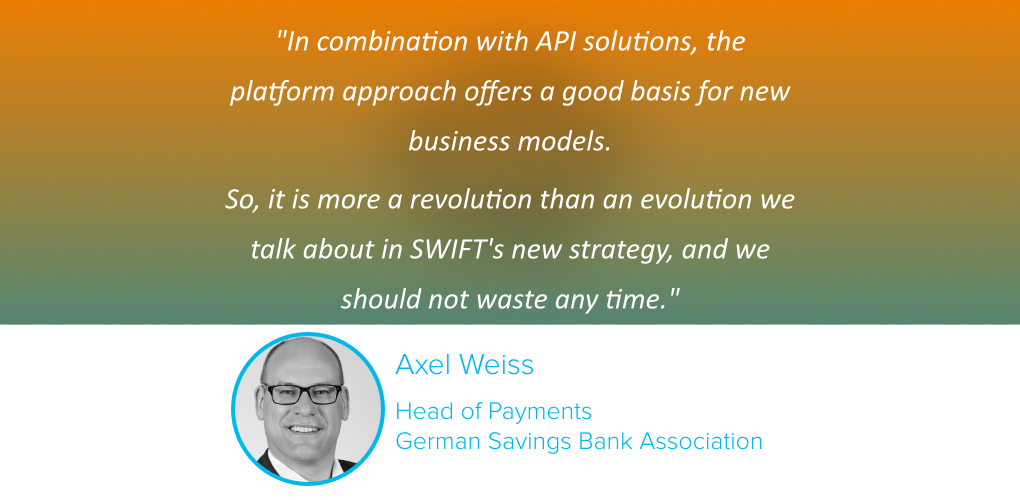
Insights & Opinions
Shaping the Future of Financial Services: Interview With German Savings Bank Association
Wed, 02 Dec 2020

At ’SWIFT’s ‘Community Update – Focus on Europe’, The Banking Scene spoke to Axel Weiss, Head of Payments at the German Savings Bank Association (Deutscher Sparkassen- und Giroverband/ DSGV) about the latest trends in payments and what the impact of SWIFT’s new strategy is for their members. Weiss was one of the panellists in the session “Customer Insights: The Evolution of Our Platform to Enable Instant Cross-Border Payments”. We had a great conversation, and I came away with a number of interesting insights, including how the German market is structured and why SWIFTs new strategy is a game-changer, for banks of all types and sizes, including local retail and savings banks.
Could you please tell us a bit more about the DSGV: who are your members and how important are they in the German market?
DSGV is an association of about 370 savings banks and 5 Landesbanks. These Landesbanks have an umbrella function, with each savings bank being connected to a Landesbank in each region.
We cover more than 40% of the current account market in Germany, which makes us a market leader in the retail segment, as well as in corporate customer business, where we manage over 30% of the market.
Our association has around 350 employees, and our role is to defend the interests of our members. The difference with most other associations is that we also have a strategical and a product development function. The main technical provider for our group is Finanz Informatik, which is responsible for the IT infrastructure of all savings banks, including payment processing.
SWIFT will provide backward compatibility when rolling out its platform. Would you consider your organisation a front runner in the latest SWIFT innovations, or will you take advantage of being able to adapt to the new strategy at your own pace?
Our strategic focus is private customers (and SMEs) rather than large corporates and the volumes of cross-border transactions that savings banks process tend to be relatively low. We are therefore not in all cases the front-runners in this space, but we try to be at least a fast follower, focusing on features that are good for our customers.
SWIFT gpi is one of those features that we try to implement as fast as possible for all savings banks. Almost all Landesbanks have already introduced this service. Our role is to create awareness about the advantages of gpi for the members, and we have organised several sessions to help them understand the importance of gpi.
Some savings banks were easier to convince than others, given that the savings bank sector does not tend to be particularly specialised, especially when it comes to cross-border. So, given that we have one infrastructure for all our members and we truly believe in SWIFT gpi, we have ended up mandating it across the whole sector.
Hearing that only about 2% of your member’s transactions are cross-border, I interpret the new SWIFT platform as an excellent opportunity to benefit from mutualised services on this platform. What would you consider the biggest advantage of the new SWIFT strategy for your organisation?
The platform approach has clear advantages for our members and, if well implemented, will represent a major step forward for the cooperative. SWIFT was founded in 1974, with the first live messages being sent across the network actions in 1977. Former colleagues that are now retired were extremely proud to be part of that story, for good reasons, and I am convinced they would be just as proud of SWIFT’s platform strategy today and its move towards transaction management.
It is good to scan the market for best practices approaches, to learn from them, to adapt, to rethink things and to focus on an approach that builds new processes rather than making changes to old ones. Only by doing this is it possible to keep an edge and compete with new players.
This is why I believe we should try for a revolution instead of an evolution. I hope that SWIFT and its members will take that chance and I am delighted to be part of the User Group for the new platform approach and to collect and contribute the German community’s views on the new strategy.
I would have expected that for savings banks, the most significant advantage would be the cost reduction for the banks.
It is a combination, an interlinking, of course. A lean cost of processing will also influence the price for the customer. In a survey we conducted among our customers about their levels of satisfaction with current account services, 50% of participants stated that a reasonable price is the most important factor to determine their satisfaction of daily banking.
So, I think we can reach both. On the one hand, we can reduce the process chain to the essentials and thus save costs, and on the other hand, we can offer services that were not possible with the previous services based on the correspondent bank network. In combination with API solutions, the platform approach offers a good basis for new business models. So, it is more a revolution than an evolution we talk about here, and we should not waste any time.

You referred to the need to have more European-wide interoperability, but with the right model in place, keeping in mind the limited 2% of your members’ transactions being cross-border. Are your customers waiting for a European solution?
If you ask the customer, they will say they have all the means of payment required for their daily banking. In Germany, that is in addition to the traditional means of payment, like credit transfers and direct debits our debit card product “girocard”. This portfolio is supplemented by the relatively new instant payment product, which we have launched very successfully on the market. Overall, I think it’s true to say that our average customer does not see a real problem.
The European market is very diverse, with each region having its own habits. Look, for example at France, where round about 90% of all e-commerce payments are card-based, whereas, in Germany, it is only 13%. But as far as Europe as a whole is concerned, the fact is, that many transactions are carried out by non-European suppliers.
This not only has an impact on revenues or financial aspects; we should keep in mind that every transaction that is not initiated through a bank account, is a loss of data for the banks. This information and insights from our customers are vital.
EPI (European Payments Initiative) is an initiative of the leading European banks for a Europe-wide payment solution, that is designed to bring benefits to our customers and also to merchants, and that could lead to more independence with regards to worldwide operating players. There is great hope that, for example, a European solution for e- and m-commerce payments can help to regain market share, as many merchants operate on a pan-European basis and there is undoubtedly a market need for a uniform approach across Europe.
For many years now, we have a single currency, and I believe the time is right to start thinking about a less fragmented market in terms of payment solutions. And why we shouldn’t we think in larger dimensions, for example, to create a worldwide acceptance network of our payment products?
What do you think about CBDC (Central Bank Digital Currency)?
The ECB and the European institutions are taking initiatives in this area with the intention of adopting a euro-based approach rather than relying on external solutions.
At the moment, nobody really knows how this digital currency will work in practice. The DSGV - like probably many other market participants - has set up activities to monitor current developments and investigate possible applications.
The main question is how we can safely use this digital currency and which benefit such an offer will have for our customers. However, it is already clear that such a crypto-currency will not be limited to the exchange of transactions but will also include the value retention function. The banks still enjoy a high level of customer confidence in this respect, which means that there is a good chance to successfully provide interesting services in this area.